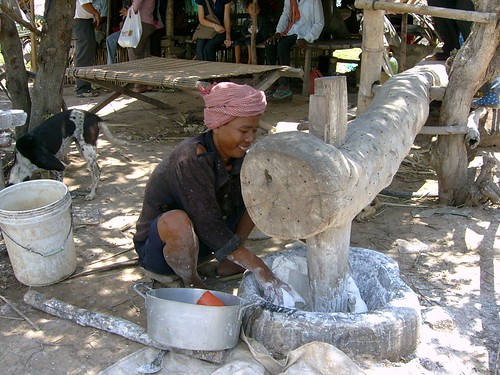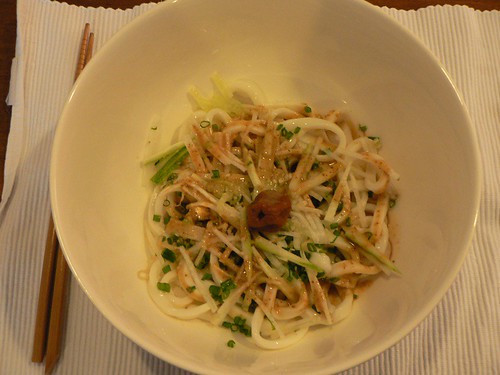Noodle Exchange
Monday, 23 April 2007 by Dr Maytel
When I was doing field work in Cambodia last year I travelled around a lot in big white four wheel drive landcruisers with Khmer project staff. We generally listened to Khmer music. The older Khmer guys loved listening to a form of Khmer folk music called "talking the blues". It has a Southeast Asian country style to it. Occasionally, they show the music on Bayon TV. It's usually 3 people, a couple of old timers guys and a woman. One plays the Chapei Dang Veng (long neck guitar). They'll talk/sing and intermittently stop for the audience to holler out "Ja ja" or "Bart bart bart" (female and male forms of yes in the Khmer language) - its a bit like when you listen to a live Curtis Mayfield album and the audience yells out in the background "I hear you brother"
The guy pictured below is considered to be the foremost virtuoso of singing the blues in Cambodia. He is known in expat circles as the Ray Charles of the Khmer blues (I tried to find some online but no luck).

Anyway, on one particular occasion, we were travelling to Prey Veng and listening to some Khmer blues and I asked my Khmer colleague "what is this song about?" (my Khmer isn't that good). Knowing the history of the country, of the killing fields and of the Khmer Rouge, American cold war bombing and repeated invasion and civil war, I expected the response to be about a tale of incredible suffering and hardship. If anyone has cause to sing the blues I thought, it's the Khmers.
"The song is about a man who bought some noodles, from his friend. The noodles are not good. And so he doesn't know what to do. He doesn't know if he should take the noodles back and risk upsetting the friendship or whether he should just keep the noodles. The noodles were expensive and his friend promised him they were great, so now he sings about his worries"
"oh"
And that's when I realised that the appeal of the blues is not to relive horrific events in one's life or the history of the country, but to talk and settle the ethical and moral problems of everyday life and relationships. How to deal with friendship relations and trade, what to do if your sold a bad bunch of noodles.
Contrary to common perception noodles are not native to Southeast Asia. Instead they were bought to Southeast Asia by successive waves of Chinese immigrants moving, trading and settling in the region. Rice noodle making as pictured below is labour intensive. It takes about 1 hour of pounding this rice and water mixture to get a kilo of noodles that are sold for about 1000 riel or $0.25. At the other end of the pole 2 small children peddle the log to pound the noodles. Generally most Cambodians make noodles only for the new years, which I think is another tradition picked up from the Chinese. Chinese serve noodles in the new year as they signify longevity.

I found generally that in-village noodle making occured in denser villagers with more spare labour and more often in villagers closer to townships. More noodle machines were spotted in villages closer to Vietnam also, where the ubiquitous pho noodle reigns supreme. (This was just my noodle observations, they may not be true).
But despite the fact that noodles are not indigenous to Cambodia, this is where I picked up a recipe for one of my most favourite at home noodle dishes. I got the recipe from the owners of my favourite Japanese restaurant in Siem Reap where I often went to dine on their Umeboshi Cold Udon. Luckily I never once was faced with the dialemma of being served bad noodles.
Cold Umeboshi Plum Udon Noodles Recipe for 1 - 2 people

Udon noodles (portion per person)*
Japanese Sesame Dressing
Spring Onion chopped
Daikon raddish (cut into batons)
Cucumber (cut into batons)
Ginger (cut into batons)
Umeboshi Plum
Japanese Sesame Dressing
You can buy this at the store or you can make it yourself. I usually just buy the dressing and then beef it up a bit.
- sesame paste 2 tblspn or so
- sesame oil couple of drops
- minced ginger (1/2 tspn)
- minded garlic (1/2 tspn)
- wasabi paste (little blob)
- mushed up umeboshi
- garlic powder
- sesame seeds whole
- japanese rice vinegar
- little bit of honey or sugar
Boil udon until cooked and plunge into ice cold water. Arrange batons of veges and sprinkle over spring onion. Top with an umeboshi plum and serve with sesame dressing
* You can use cold soba or somen too
The guy pictured below is considered to be the foremost virtuoso of singing the blues in Cambodia. He is known in expat circles as the Ray Charles of the Khmer blues (I tried to find some online but no luck).

Anyway, on one particular occasion, we were travelling to Prey Veng and listening to some Khmer blues and I asked my Khmer colleague "what is this song about?" (my Khmer isn't that good). Knowing the history of the country, of the killing fields and of the Khmer Rouge, American cold war bombing and repeated invasion and civil war, I expected the response to be about a tale of incredible suffering and hardship. If anyone has cause to sing the blues I thought, it's the Khmers.
"The song is about a man who bought some noodles, from his friend. The noodles are not good. And so he doesn't know what to do. He doesn't know if he should take the noodles back and risk upsetting the friendship or whether he should just keep the noodles. The noodles were expensive and his friend promised him they were great, so now he sings about his worries"
"oh"
And that's when I realised that the appeal of the blues is not to relive horrific events in one's life or the history of the country, but to talk and settle the ethical and moral problems of everyday life and relationships. How to deal with friendship relations and trade, what to do if your sold a bad bunch of noodles.
Contrary to common perception noodles are not native to Southeast Asia. Instead they were bought to Southeast Asia by successive waves of Chinese immigrants moving, trading and settling in the region. Rice noodle making as pictured below is labour intensive. It takes about 1 hour of pounding this rice and water mixture to get a kilo of noodles that are sold for about 1000 riel or $0.25. At the other end of the pole 2 small children peddle the log to pound the noodles. Generally most Cambodians make noodles only for the new years, which I think is another tradition picked up from the Chinese. Chinese serve noodles in the new year as they signify longevity.

I found generally that in-village noodle making occured in denser villagers with more spare labour and more often in villagers closer to townships. More noodle machines were spotted in villages closer to Vietnam also, where the ubiquitous pho noodle reigns supreme. (This was just my noodle observations, they may not be true).
But despite the fact that noodles are not indigenous to Cambodia, this is where I picked up a recipe for one of my most favourite at home noodle dishes. I got the recipe from the owners of my favourite Japanese restaurant in Siem Reap where I often went to dine on their Umeboshi Cold Udon. Luckily I never once was faced with the dialemma of being served bad noodles.
Cold Umeboshi Plum Udon Noodles Recipe for 1 - 2 people

Udon noodles (portion per person)*
Japanese Sesame Dressing
Spring Onion chopped
Daikon raddish (cut into batons)
Cucumber (cut into batons)
Ginger (cut into batons)
Umeboshi Plum
Japanese Sesame Dressing
You can buy this at the store or you can make it yourself. I usually just buy the dressing and then beef it up a bit.
- sesame paste 2 tblspn or so
- sesame oil couple of drops
- minced ginger (1/2 tspn)
- minded garlic (1/2 tspn)
- wasabi paste (little blob)
- mushed up umeboshi
- garlic powder
- sesame seeds whole
- japanese rice vinegar
- little bit of honey or sugar
Boil udon until cooked and plunge into ice cold water. Arrange batons of veges and sprinkle over spring onion. Top with an umeboshi plum and serve with sesame dressing
* You can use cold soba or somen too

great post!
and i am going to test drive those noodles very soon (i'm starting to talk like the guy in the ribs vid)
oooh yeah, thaaat's it, baby, give me some of those ribs..oooo yeah and some of that hot sauce
the background music is the best huh...